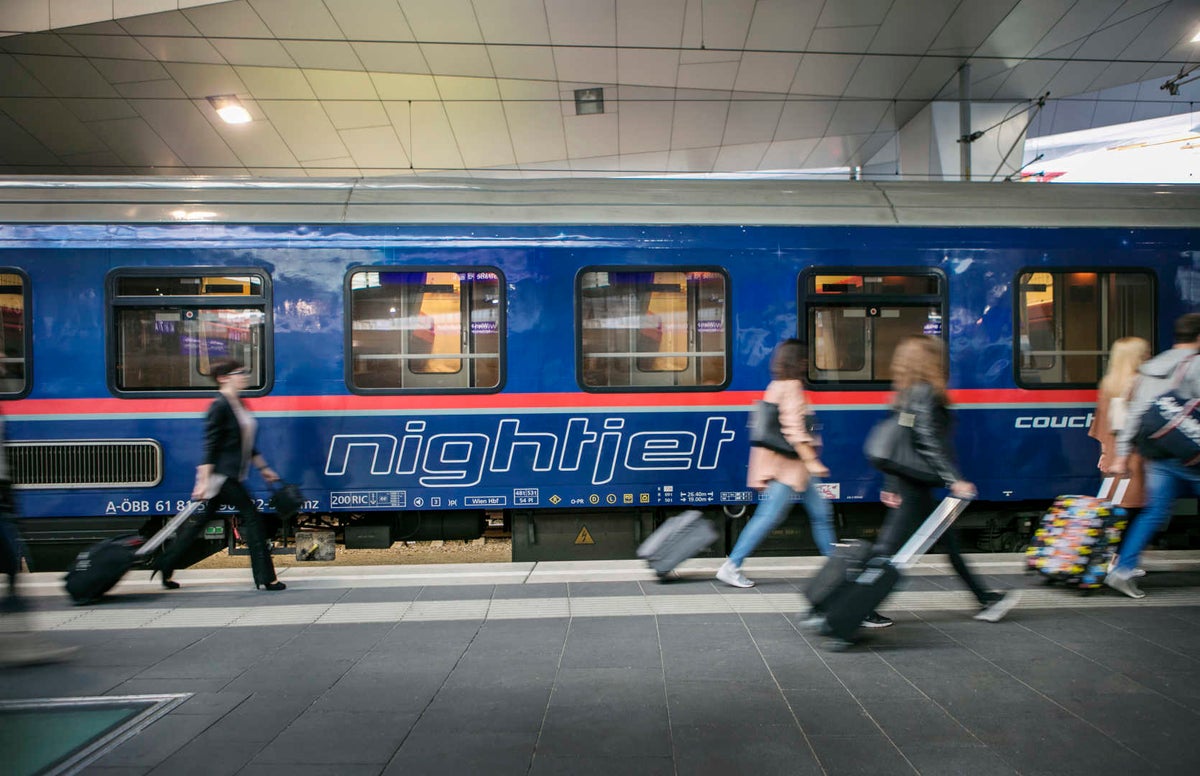
Before budget airlines took off in Europe, many people made long intercity journeys by overnight train. As the likes of easyJet and Ryanair expanded, though, many of the sleeper connections were cut – including the German Railways link from Berlin to Paris.
But now the two most important capitals in continental Europe are once again linked – thanks to a new Austrian Railways Nightjet service.
For decades, Paris Gare de l’Est was the departure point for the most celebrated international train in the world. L’Express d’Orient departed daily from Paris via Vienna and Belgrade to Istanbul.
The Orient-Express was subject to death by a thousand cuts, ending its term as Europe’s premier train in 2009, by which stage it was a mere overnight link between Strasbourg and Vienna.
A combination of accelerated day trains – for example, a new line halving the four-hour journey between Paris and Strasbourg – and low-cost flying seemed to be driving the international sleeper train to extinction. In 2014 German Railways axed the Paris-Berlin link and the following year ended its overnight operations altogether.
Yet Tuesday 12 December may come to be celebrated as the day the railway fought back. Nine years to the day after the last German Railways overnight express to Berlin left Gare de l’Est, the revived overnight sleeper train from the German capital arrived in Paris.
How significant is this?
Railway people – and environmentalists across Europe – are jubilant at what they believe is a highly significant move. The German and French capitals are once again connected by an overnight train, signalling an important step in rebuilding a pan-European network of sleeper trains.
Mark Smith, the international rail guru known as The Man in Seat 61, said: “The Paris-Berlin Nightjet restores a key link between east and west and it’s going to be popular – it’s already sold out for Friday and various other dates.”
Austrian Railways believes the European overnight train has a future, and is steadily turning the clock back to before the budget airline revolution that began almost three decades ago.
The answer lies in keeping the cost of the rail operation low and the quality high. That is what the last company to run between Berlin and Paris, Russian Railways, sought to do.
What’s the Russian connection?
After German Railways abandoned its “City Night Line” service in 2014, Russian Railways took over. It ran the intercity link as an extension of its train from Moscow to Berlin right up until March 2020, when the frontiers of Europe clattered shut due to the Covid pandemic.
The ending of the link had jeopardised the very long-standing link between Moscow and Paris; previously, sleeping carriages from the Russian capital were attached to the train from Berlin.
When this prestige route ended, Russian Railways decided to run its own trains on the route, to the delight of rail travellers between Berlin and Paris.
Nicky Gardner, co-editor of Europe by Rail: The Definitive Guide, recalls: “This Russian train was well used by Berliners. Summer loadings were good, winter ones less so. But it was fun. I used it several times, as it was the perfect overnight route to London via Paris.
“Excellent Polish restaurant car with a quirky menu (eg kangaroo steak with South African wine). By early 2020, it was just once-weekly and the last train ran in mid-March 2020, when it was stopped on account of the pandemic.”
Russian Railways will not be back for some time. But meanwhile the new incumbent, Austrian Railways, will find out this winter whether slow travel between Berlin and Paris has a future.
What’s the attraction of an overnight train?
“Climate-conscious travellers are turning to rail for increasingly long distances,” says Mark Smith. “They’re rediscovering what some of us have never forgotten: a 12-hour overnight journey while you sleep is far more time-effective than a seven-hour high-speed daytime journey – or even, perhaps, five daytime hours of airports and flight.”
If you have a long journey to make – and Berlin to Paris is 550 miles – then an overnight sleeper train is probably the most civilised way to do it. You can have dinner before you leave, then step aboard and into a six-person compartment with couchettes. These are basically camp beds that fold down, three on each side, rather like a very high-density youth hostel dorm.
If you subscribe to the belief of the great Parisian philosopher Jean-Paul Sartre that “hell is other people” you might not enjoy the experience. A “mini cabin” for solo travellers is available at a higher price. Either way, you save on a night’s accommodation and hopefully arrive well rested and ready for a day in the French capital.
How do costs compare?
Flying is cheaper. Comparing prices two weeks ahead, I saw I could pay €80 for a “couchette” berth in a compartment for six on the Nightjet. I could have taken my pick from a dozen flights from Berlin to Paris, starting at €65 for a trip of less than two hours.
People who value frequency on journeys won’t be spoilt for choice – there’s no Berlin-Paris service on day two of the new operation, because the carriages will be going in the opposite direction.
Since the sleeper train slipped away, many overnight bus services have sprung up that are quicker and much cheaper between Berlin and Paris, though you don’t get a bed on board.
Where else in Europe are sleeper trains thriving?
A new venture this year, called simply European Sleeper, runs through the night from Brussels and Amsterdam to Berlin, and it is being extended to Prague. Croatian Railways runs a sleeper from Stuttgart in Germany to the Slovenian capital, Ljubljana. And Polish State Railway is extending its Warsaw-Vienna sleeper Chopin to Salzburg and Munich.
Mostly, though, sleeper trains run within a single, large country.
France has a few between Paris and the south, including a new service to a town called Aurillac which few people know much about nor care to visit. This is an example of local politicians having some sway in connecting their locations with the capital.
A fair few trains run the length of Italy. In Scandinavia, Sweden, Finland and Norway have their own versions of Arctic expresses. In the UK, you can choose from London to Penzance via Plymouth or from the English capital to Edinburgh, Glasgow, Inverness, Aberdeen and Fort William.
Why are there no sleeper trains from London to Berlin or Manchester to Paris?
From 1936 to 1980 an overnight train linked London with Paris. It was loaded on a ferry at Dover and emerged at Dunkirk to continue through the night to the French capital.
When Eurostar passenger trains through the Channel Tunnel were first conceived, the idea was that there would be trains from Scotland and Manchester direct to Paris. But that was kiboshed by the budget airlines – the flights are so cheap and the trains would have been very expensive. So even though the trains were built, they never ran.
One reason trains through the night will not be on the departure boards any time soon is that safety rules for the Channel Tunnel are extremely strict – so the sleeping carriages on the new Berlin to Paris train would not be allowed to run from Berlin to London.







